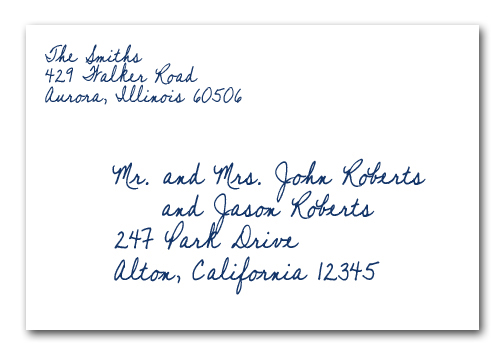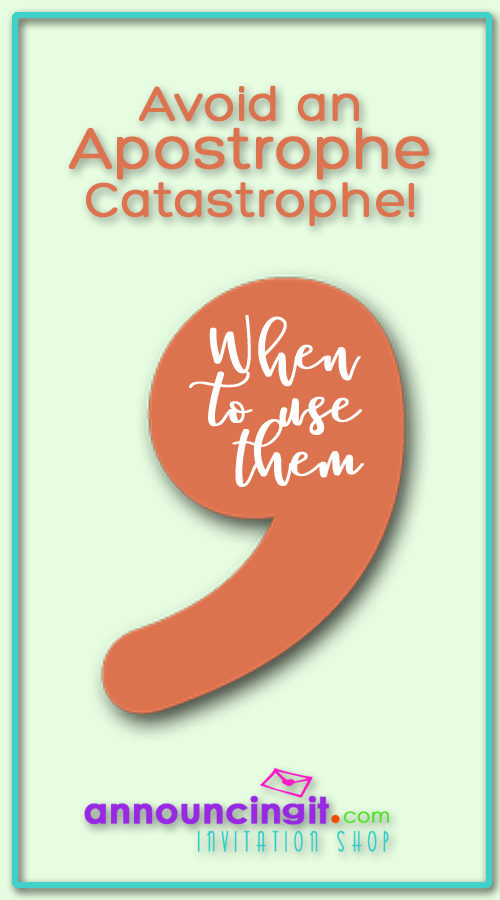When and Where do you use Apostrophes?
20% off INVITATIONS | Use Discount Code DOINVITEU20
When and where to use apostrophes is the most asked question when wording invitations or on return address labels.
DO NOT use an apostrophe on your return address!
This the number one mistake made on invitations (See rule 1 below). On a return address is using an apostrophe on a last name:
- The Smiths is plural for "Smith" and means there is more than one person named Smith and the invitation is from them all. When in doubt, we like to use "The Smith Family".
- The Smith's (with an apostrophe before the s) is the possessive of "Smith" and indicates one person ownership.
- The Smiths' (with an apostrophe after the s) is plural possessive and means the possession of more than one "Smith" of something (see Rule 2 below) like "The Smiths' house is white."
So, the proper grammar for your return address is "The Smiths" or "The Smiths invite you ..." as you are using the plural form of the name = Smiths, not possessive form (Smith's or Smiths'), so no apostrophe, please!

DO NOT use an apostrophe to sign your names!
When signing your Christmas cards or thank you notes with your names:
"Happy Holidays from the Smiths"
there is no apostrophe as you mean "plural" as the message is from all the people of the Smith family.
Grammar Rules and the Use of Apostrophes:
Rule 1. Do not use an apostrophe for the plural of a name.
Examples: We visited the Sanchezes in Los Angeles.
We visited the Sanchezes in Los Angeles.
Rule 2. To show plural possession, make the noun plural first. Then immediately use the apostrophe.
Examples: the Changs' house
the Millers' golf clubs
the Strauses' daughter
the Sanchezes' artwork
the Halstons' appointment
the Lemons' books
the boys' hats
the women's hats
the actresses' hats
the children's hats
Rule 3. Use the apostrophe to show possession. Place the apostrophe before the s to show singular possession.
Examples: one boy's hat
one woman's hat
one actress's hat
one child's hat
one woman's hat
Ms. Chang's house
NOTE: Although names ending in s or an s sound are not required to have the second s added in possessive form, it is preferred.
Mr. Jones's golf clubs
Texas's weather
Ms. Straus's daughter
Jose Sanchez's artwork
Dr. Hastings's appointment (name is Hastings)
Mrs. Lees's books (name is Lees)
Rule 4. Use the apostrophe where the noun that should follow is implied.
Example: This was his father's, not his, jacket.
Rule 5. Use the apostrophe with contractions. The apostrophe is always placed at the spot
where the letter(s) has been removed.
Examples: don't, isn't
You're right.
She's a great teacher.
Rule 6. With a singular compound noun, show possession with 's at the end of the word.
Example: my mother-in-law's hat
Rule 7. If the compound noun is plural, form the plural first and then use the apostrophe.
Example: my two brothers-in-law's hats
Rule 8. Use the apostrophe and s after the second name only if two people possess the same item.
Examples: Cesar and Maribel's home is constructed of redwood. (Joint ownership.)
Cesar's and Maribel's job contracts will be renewed next year. (Separate ownership.)
Cesar and Maribel's job contracts will be renewed next year.
(Joint ownership of more than one contract.)
Rule 9. Never use an apostrophe with possessive pronouns (show that something belongs to someone):
his, hers, its, theirs, ours, yours, my, whose. They already show possession so they do not require an apostrophe.
Examples: The white house is theirs.
The dog lost its toy.
Rule 10. The only time an apostrophe is used for it's is when it is a contraction for it is or it has.
Examples: It's a nice day.
It's your right to refuse the invitation.
It's been great getting to know you.
Rule 11. The plurals for capital letters and numbers used as nouns are not formed with apostrophes.
Examples: She consulted with three M.D.s.
BUT
She went to three M.D.s' offices.
(The apostrophe is needed here to show plural possessive.)
She learned her ABCs.
the 1990s not the 1990's
the '90s or the mid-'70s not the '90's or the mid-'70's
She learned her times tables for 6s and 7s.
Exception: Use apostrophes with capital letters and numbers when the meaning would be unclear otherwise.
Examples: Please dot your I's. (You don't mean Is.)
Ted couldn't distinguish between her 6's and 0's. (You don't mean Os.)
Rule 12. Use the possessive case in front of a gerund (-ing word).
Examples: Alex's skating was a joy to behold.
This does not stop Joan's inspecting of our facilities next Thursday.
Rule 13. If the gerund has a pronoun in front of it, use the possessive form of that pronoun.
Examples: I appreciate your inviting me to dinner.
I appreciated his working with me to resolve the conflict.

Next:
What to include on your invitations
Dress Codes and How to Dress for Events
When to Mail Party Invitations
20% off INVITATIONS | Use Discount Code DOINVITEU20
